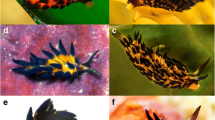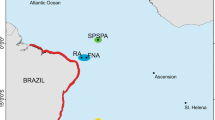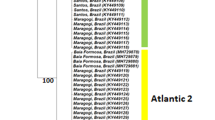Abstract
The current classification of the Malagasy-Comoroan geckos of the genus Geckolepis recognizes three valid species and is based on morphological differences only. Species allocation of individuals is difficult, mainly because of the insufficiently known degree of variation and the frequent partial loss of the integument in preserved specimens. Here we study Geckolepis specimens from almost their entire known range. We combine molecular and morphological data to estimate species richness in the genus, and to assess the taxonomic validity of the morphological differences proposed. Analyses of mitochondrial (12S, ND4) and nuclear (RAG1, CMOS) gene sequences support three major clades in addition to the morphologically distinct G. polylepis (included for 12S only), and the presence of various divergent lineages within these clades, some occurring in sympatry. Among lineages, the external morphology seems to be comparatively conservative, and differences are faint in many cases. For each major lineage, we summarize the most diagnostic morphological characters that distinguish it from other lineages. The combined molecular and morphological data strongly indicate the presence of highly divergent lineages, three of which are tentatively referred to the names Geckolepis maculata, G. polylepis and G. typica, whereas three other major lineages are considered Confirmed Candidate Species. Among the remaining lineages, differentiation is shallower, and these may qualify for Deep Conspecific Lineages. In conclusion, our analysis provides evidence for an underestimation of species richness in the genus and a complex evolutionary history, not reflected by current Geckolepis species-level taxonomy.


Similar content being viewed by others
References
Angel, F. (1942). Les lézards de Madagascar. Memoires de l'Académie Malgache, 36, 1–139.
Arévalo, E., Davis, S. K., & Sites, J. (1994). Mitochondrial DNA sequence divergence and phylogenetic relationships among eight chromosome races of the Sceloporus grammicus complex (Phrynosomatidae) in Central Mexico. Systematic Biology, 43, 387–418.
Avise, J. C., & Ball, R. M. (1990). Principles of genealogical concordance in species concepts and biological taxonomy. In D. Futuyma & J. Antonovics (Eds.), Surveys in Evolutionary Biology ((pp, Vol. 7, pp. 45–67). Oxford: Oxford University Press.
Bauer, A., Glaw, F., Gehring, P.-S., & Vences, M. (2011). New species of Blaesodactylus (Squamata: Gekkonidae) from Ankarafantsika National Park in north-western Madagascar. Zootaxa, 2942, 57–68.
Brygoo, E. R. (1987). L'endémisme des reptiles de Madagascar. Bulletin de la Societé Zoologique de France, 112, 5–38.
Clement, D. M., Posada, D., & Crandall, K. A. (2000). TCS: a computer program to estimate gene genealogies. Molecular Ecology, 9, 1657–1659.
Crottini, A., Gehring, P.-S., Glaw, F., Harris, D. J., Lima, A., & Vences, M. (2011). Deciphering the cryptic species diversity of dull-coloured day geckos Phelsuma (Squamata: Gekkonidae) from Madagascar, with description of a new species. Zootaxa, 2982, 340–348.
Glaw, F., & Vences, M. (1994). A Fieldguide to the Amphibians and Reptiles of Madagascar, 2nd ed. (pp. 480) Köln: Vences & Glaw Verlag.
Glaw, F., & Vences, M. (2007). A Field Guide to the Amphibians and Reptiles of Madagascar, 3rd ed. (pp. 496). Köln: Vences & Glaw Verlag.
Greenbaum, E., Bauer, A. M., Jackman, T. R., Vences, M., & Glaw, F. (2007). A phylogeny of the enigmatic Madagascan geckos of the genus Uroplatus (Squamata: Gekkonidae). Zootaxa, 1493, 41–51.
Greenbaum, E., Jackman, T., & Bauer, A. M. (2007). Homopholis and Blaesodactylus (Squamata: Gekkonidae) revisited: new insights from a molecular phylogeny. African Journal of Herpetology, 56, 101–114.
Han, D., Zhou, K., & Bauer, A. M. (2004). Phylogenetic relationships among gekkotan lizards inferred from Cmos nuclear DNA sequences and a new classification of the Gekkota. Biological Journal of the Linnean Society, 83, 353–368.
Jackman, T. R., Bauer, A. M., Greenbaum, E., Glaw, F., & Vences, M. (2008). Molecular phylogenetic relationships among species of the Malagasy-Comoran gecko genus Paroedura (Squamata: Gekkonidae). Molecular Phylogenetics and Evolution, 46, 74–81.
Köhler, G., Diethert, H.-H., Nussbaum, R. A., & Raxworthy, C. J. (2009). A revision of the fish scale geckos, genus Geckolepis Grandidier (Squamata, Gekkonidae) from Madagascar and the Comoros. Herpetologica, 65, 419–435.
Librado, P., & Rozas, J. (2009). DnaSP v5: A software for comprehensive analysis of DNA polymorphism data. Bioinformatics, 25, 1451–1452.
Nagy, Z. T., Sonet, G., Glaw, F., & Vences, M. (2012). First large-scale DNA barcoding assessment of reptiles in the biodiversity hotspot of Madagascar, based on newly designed COI primers. PLoS ONE, 7, e34506.
Nylander, J. A. A. (2004). MrModeltest version 2.3. Evolutionary Biology Centre. Uppsala: Uppsala University.
Padial, J. M., Castroviejo-Fisher, S., Köhler, J., Vilà, C., Chaparro, J. C., & De la Riva, I. (2009). Deciphering the products of evolution at the species level: the need for an integrative taxonomy. Zoologica Scripta, 38, 431–447.
Padial, J. M., Miralles, A., De la Riva, I., & Vences, M. (2010). The integrative future of taxonomy. Frontiers in Zoology, 7, article 16.
Palumbi, S., Martin, A., Romano, S., McMillan, W. O., Stice, L., & Grabowski, G. (1991). The simple fool’s guide to PCR Version 2. Hawai: Honululu.
Ronquist, F., & Huelsenbeck, J. P. (2003). MrBayes 3: Bayesian phylogenetic inference under mixed models. Bioinformatics, 19, 1572–1574.
Schubert, C., & Christophers, E. (1985). "Dermolytische Schreckhäutung", ein besonderes Autotomieverhalten von Geckolepis typica (Reptilia, Gekkonidae). Zoologischer Anzeiger, 214, 129–141.
Schubert, C., Steffen, T., & Christophers, E. (1990). Weitere Beobachtungen zur "dermolytischen Schreckhäutung" bei Geckolepis typica (Reptilia, Gekkonidae). Zoologischer Anzeiger, 224, 175–192.
Stephens, M., Smith, N. J., & Donnelly, P. (2001). A new statistical method for haplotype reconstruction from population data. American Journal of Human Genetics, 68, 978–989.
Templeton, A. R., Crandall, K. A., & Sing, C. F. (1992). A cladistic analysis of phenotypic associations with haplotypes inferred from restriction endonuclease mapping and DNA sequence data. Cladogram estimation. Genetics, 132, 619–633.
Vieites, D. R., Wollenberg, K. C., Andreone, F., Köhler, J., Glaw, F., & Vences, M. (2009). Vast underestimation of Madagascar's biodiversity evidenced by an integrative amphibian inventory. Proceedings of the National Academy of Science of the U.S.A., 106, 8267–8272.
Wermuth, H. (1965). Liste der rezenten Amphibien und Reptilien. Gekkonidae, Pygopodidae, Xantusiidae. Das Tierreich, 80, 1–246.
Acknowledgements
We are grateful to Franco Andreone, Parfait Bora, Neil D’Cruze, Hildegard Enting, Michael Franzen, Frank Glaw, Kathrin Glaw, Angelika Knoll, Aurelien Miralles, Zoltan Nagy, Jasmin E. Randrianirina, Fanomezana M. Ratsoavina, Angelin and Angeluc Razafimanantsoa, and Augustin Sarovy for help during fieldwork and/or collection of crucial samples. Wolfgang Böhme (ZFMK), Frank Glaw (ZSM), Gunther Köhler (SMF) and Mark-Oliver Rödel (ZMB) allowed examination of specimens held in their care. Special thanks to Frank Glaw for sharing data and photos. Fieldwork was carried out in the framework of collaboration accords with the Département de Biologie Animale, Université d'Antananarivo, Madagascar. We are grateful to the Malagasy authorities for collection and export permits.
Author information
Authors and Affiliations
Corresponding author
Appendices
Appendix 1
List of Geckolepis voucher specimens examined morphologically for this study. Order of listing follows the allocation to OTUs as mentioned in the text above. Field numbers in parentheses, as used in Fig. 1.
OTU AB (= G. maculata ): ZSM 1521/2008 (FGZC 1925), Ampombofofo; ZSM 1520/2008 (FGZC 1697), ZSM 2164/2007 (FGZC 1232), Forêt d'Ambre; ZSM 523/2000 (FGMV 2000.275), ZSM 998/2003 (FGMV 2002.3009), Montagne des Français; ZMB 9655 (holotype of G. maculata), "Anfica"; SMF 9202-9204, SMF 9206–9207, SMF 57180, ZFMK 51814-815, ZSM 19/1921, ZSM 434/2000 (FGMV 2000.223), Nosy Be; ZFMK 61566–571, Nosy Mitsio; ZSM 435/2000 (FGMV 2000.833), Nosy Sakatia.
OTU C: ZSM 210/2002 (MV2001.1460), Andranofotsy; ZSM 143/2005 (FGZC 2633), Ste. Luce; SMF 9213, Ile aux Prunes; SMF 73582, ZFMK 47259–260, ZFMK 48157, ZFMK 51816, Nosy Boraha.
OTU D: ZSM 289/2004 (FGZC 554), ZSM 2126/2007 (FGZC 1144), Ankarana.
OTU EFG: ZSM 765–766/2003 (FGMV 2002.569-570), ZSM 780/2003 (FGMV 2002.597), ZSM 1522/2008 (FGZC 1605), Ankarana; ZSM 2138/2007 (FGZC 1176), Forêt de Orangea (east of Ramena); ZSM 2202–2203/2007 (FGZC 1309, 1311), Nosy Hara; ZSM 522/2000 (FGMV 2000.273), ZSM 998/2003 (FGMV 2002.3009), ZSM 2112/2007 (FGZC 1110), ZSM 1523/2008 (FGZC 1971), Montagne des Français.
OTU HI: ZSM 489/2001 (MV 2001.357), Ankarafantsika; ZSM 49–50/2006 (FGZC 773, 777), ZSM 104/2006 (FGZC 882), ZSM 110/2006 (FGZC 891), ZSM 141/2006 (FGZC 949), Tsingy de Bemaraha.
OTU K (= G. typica ): SMF 22635, Amboasary, SMF 57182–183, Ambovombé; SMF 80772, Fort Dauphin; SMF 9222, Andranohinaly, ZSM 36/2004 (FGZC 57), Ampanihy; ZSM 582/2000 (FGMV 2000.565), Andatabo; ZSM 581/2000 (FGMV 2000.591), La Mangrove; ZSM 142/2005 (FGZC 2552), Esomony.
Geckolepis polylepis: SMF 9217 (lectotype), SMF 9218–9121 (paralectotypes), ZSM 309/0 (paralectotype), Mahajanga; ZSM 840/2012 (ZCMV 12753), ZSM 1605/2010 (ZCMV 12752), Kirindy.
Appendix 2
Additional specimens of Geckolepis sequenced for the mitochondrial 12S gene only and assigned by 12S data to the OTUs represented in Fig. 1 (field numbers in parentheses).
OTU A: UADBA (FGZC 3122), Forêt d'Ambre; UADBA (FGZC 1939) Montagne des Français. OTU C: UADBA (FGMV 2002.A23), Andranofotsy; ZSM 318/2006 (ZCMV 3385), Nosy Boraha. OTU F: ZSM 2112/2007 (FGZC 1110), UADBA (FGZC 1111, 1970), ZSM 912/2003 (FGMV 2002.939), UADBA (FGMV 2002.938), Montagne des Français. OTU G: ZSM 780/2003 (FGMV 2002.597), Ankarana. OTU H: ZSM 49–50/2006 (FGZC 773, 777), Tsingy de Bemaraha. OTU I: ZSM 141/2006 (FGZC 949) UADBA (FGZC 892), Tsingy de Bemaraha. OTU J: UADBA (FGMV 2002.1525), near Toliara. Geckolepis polylepis: ZSM 1605/2010 (ZCMV 12752), UADBA (ZCMV 12711, 12730, 12748), Kirindy.
Rights and permissions
About this article
Cite this article
Lemme, I., Erbacher, M., Kaffenberger, N. et al. Molecules and morphology suggest cryptic species diversity and an overall complex taxonomy of fish scale geckos, genus Geckolepis . Org Divers Evol 13, 87–95 (2013). https://doi.org/10.1007/s13127-012-0098-y
Received:
Accepted:
Published:
Issue Date:
DOI: https://doi.org/10.1007/s13127-012-0098-y




